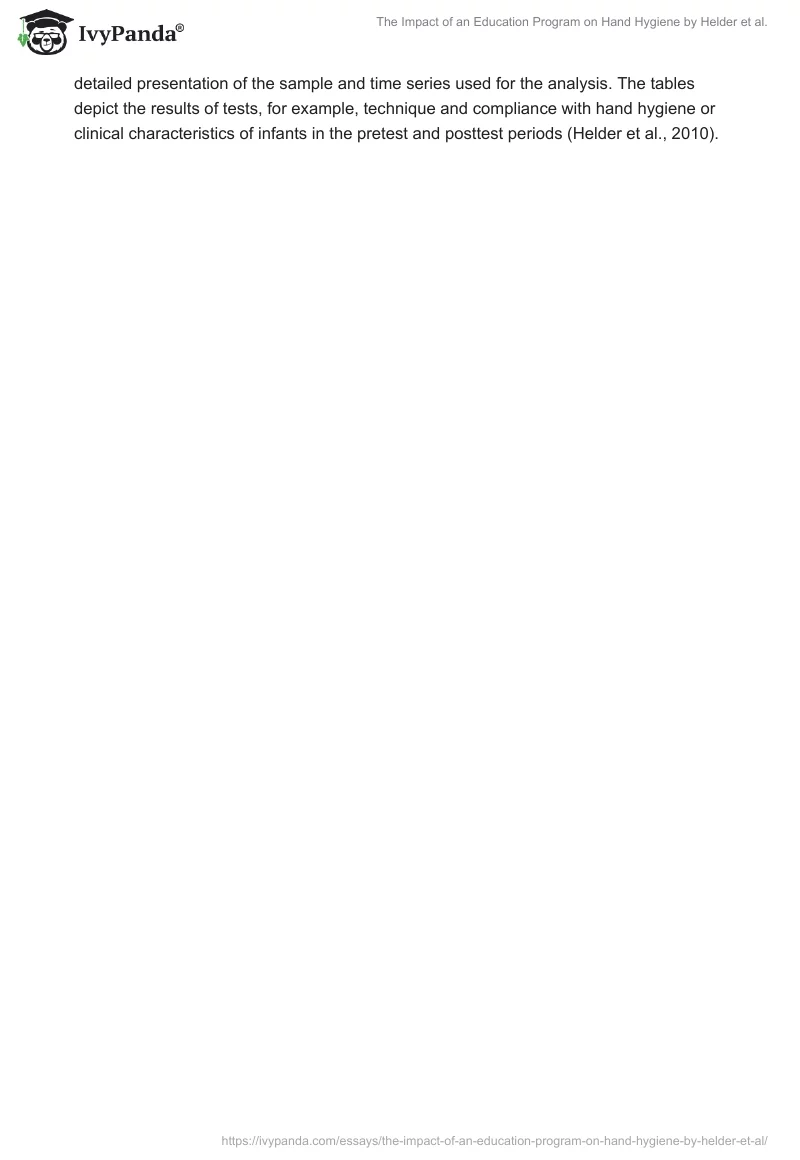Inferential Statistics and Critique
The study under analysis uses inferential statistics. The statistical tool applied to analyze the intervention was a segmented log-linear regression analysis of interrupted time-series data. It implies the division of time series into pretest and posttest components. SPSS 15 version and R version 2.7.1 were used to perform the analysis (Helder, Brug, Looman, van Goudoever, & Kornelisse, 2010). The article does not provide the value of inferential statistics or the degrees of freedom. The statistical significance of p-Values for multiple testing on the completeness of hand rubbing was estimated at the point of less than.01. For the other tests, the statistical significance of p-Values was defined as less than.05. Multilevel analysis was not appropriate for this study since healthcare professionals involved in the experiment were observed more than once, and their characteristics were not included in the dataset.
Since ANOVA was used to analyze the differences in observation after log-transformation, it can be concluded that the tests applied in this study were parametric. This type of measure is suitable for research tasks. Moreover, they allow the measurement of variables relevant to the number of groups involved in the experiment and the sample size. The article does not state the hypothesis of this research. Thus, there is no opportunity to evaluate the representation of inferential statistics in connection with the hypothesis. Nevertheless, inferential statistics correspond with the aim of the study, which is “to assess the impact of an educational program on compliance with hand hygiene and its influence on the incidence of nosocomial bloodstream infections in VLBW infants” (Helder et al., 2010, p. 1246).
The results of inferential tests are discussed in detail. The discussion is logical and clearly set. It is divided into parts to address every research problem. Pretest and posttest results are compared, and the conclusion about the statistical significance is provided. Moreover, the presentation of results in tables and figures in addition to text contributes to a better understanding of inferential statistics. Thus, the figures provide a detailed presentation of the sample and time series used for the analysis. The tables depict the results of tests, for example, technique and compliance with hand hygiene or clinical characteristics of infants in the pretest and posttest periods (Helder et al., 2010).





Data Interpretation and Conclusion
Data interpretation is detailed and well-structured. Every aspect of research, such as compliance with and completeness of hand rubbing, hand hygiene during high-risk and low-risk procedures, nosocomial bloodstream infections, etc., provided an understanding of research findings. Data used in the analysis were obtained during two pretest and two posttest stages. After the pretest period, the educational program promoting hand hygiene was applied for healthcare professionals involved in the care of infants with very low birth weight. The analysis revealed a significant increase in hand hygiene compliance both before and after patient contact (p-value 0.001) (Helder et al., 2010).
Comparing hand hygiene during high-risk and low-risk interventions, it can be concluded that it was higher during high-risk procedures and increased after the educational program (an increase from 64.4% to 85.8% during low-risk procedures and from 73.6% to 89.4% during high-risk procedures). Drying time and usage of hand alcohol also demonstrated a significant increase in the posttest period. Nevertheless, they did not achieve the recommended level. Major clinical characteristics of the VLBW infants also changed as a result of the improvement of healthcare professional hand hygiene. Thus, the frequency of nosocomial bloodstream infection significantly decreased from 44.5% to 36.1% after implementing the suggested educational program resulting in a p-value of 0.03 (Helder et al., 2010, p. 1249). On the whole, the risk of infants developing a nosocomial bloodstream infection was reduced by 18.9%. Also, the general incidence of nosocomial infections was reduced. With a 95% confidence interval, the rate of infections was 17.3 before the educational program. After the program and evident improvements of health professional hand hygiene, the infection rate decreased to 13.5 (Helder et al., 2010, p, 1450).
The article does not have a conclusion as a separate section. There is a brief concluding paragraph as a part of a discussion section. However, this discussion summarizes and generalizes the research findings and compares them to the results of previous investigations on the problem, thus concluding the presentation of the research. Thus, the final section of the research presentation provides an overview of the whole study, its limitations, applicability to practice, and implications for further research.
Implications for Further Research
The study provides several implications for further research. First of all, the findings suggest an opportunity of using alternative techniques to collect the research data. Thus, hand alcohol dispensers with the functions of time, date, and frequency of application recording can be used to reduce the Hawthorn effect. Moreover, it empowers the collection of data for a longer period of time compared to the method used in this study. Another implication is the introduction of social cognitive models into research, which will allow a better understanding of the participants’ behavior and provide a possibility of influencing healthcare professionals.
References
Helder, O., Brug, J., Looman, C., van Goudoever, J., & Kornelisse, R. (2010). The impact of an education program on hand hygiene compliance and nosocomial infection incidence in an urban Neonatal Intensive Care Unit: An intervention study with before and after comparison. International Journal of Nursing Studies, 47(10), 1245-1252. Web.


